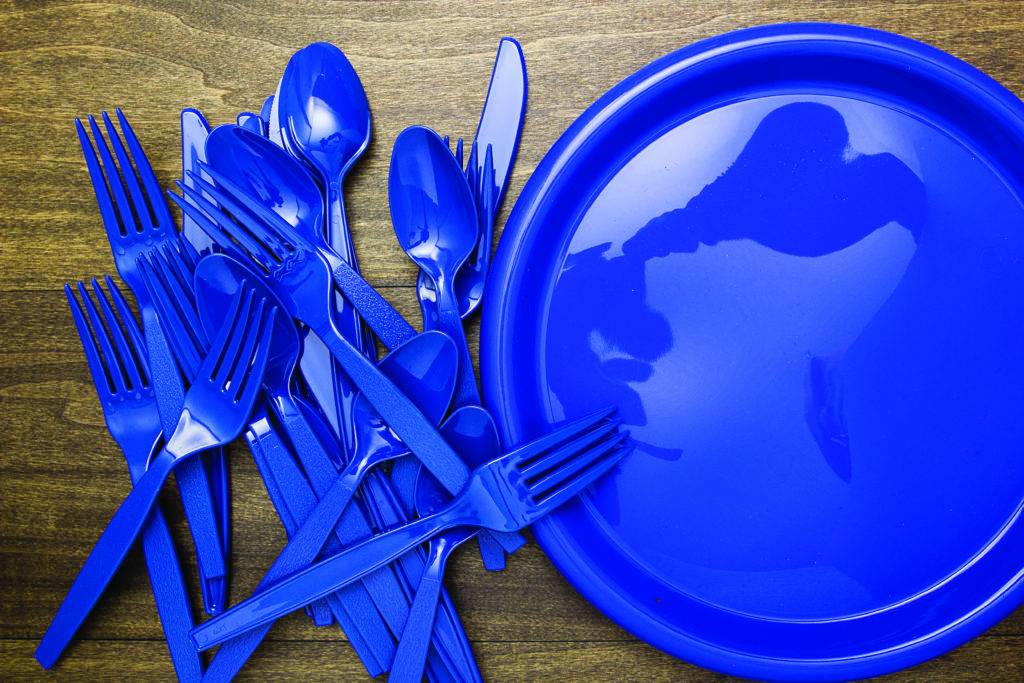What Can We Learn
From the French?
BY LISA DURANT
In 2016 France became the first country to ban plastic plates, cups, and utensils and in so doing declared disposable plastic—a mainstay of “carefree” society—no longer à la mode. The laws go into effect in 2020 and transitions are underway, with exceptions only for compostable, bio-sourced materials. Hats off to French lawmakers, who in upholding the spirit of the 2015 Paris Climate Agreement made it a priority and took decisive action. They believed that promoting a “circular economy” of waste disposal from “product design to recycling” was essential to curb global warming.
What’s interesting to consider is how carefree became a part of culture we tacitly accept as normal, proper, and advantageous. Since the 1950s marketers have promoted plastics as part of a retail mentality summarized by Victor Lebow, who counseled then President Eisenhower. Lebow said, “Our enormously productive economy … demands that we make consumption our way of life, that we convert the buying and use of goods into rituals, that we seek our spiritual satisfaction, our ego satisfaction, in consumption … We need things consumed, burned up, replaced, and discarded at an ever-accelerating rate.” Purpose, as experts explained, became consumption, a wheel that spins faster and faster.
The use of plastic was not only a marketing scheme to incent consumption, it ushered in a new era of convenience purported to help “modern” women with their home duties. Foods could be stored in plastic containers. Single-use plastic serving plates, cups, and utensils could be tossed out in lieu of cleaning them. Marketing convenience became a smash hit with Americans and fundamentally made “disposable” the national maxim and societal norm.
Companies were quick to profit from the consumption bandwagon and took it a step further by manufacturing for planned obsolescence—a methodology of deliberately designing products to fail and thus require replacement purchase. Products were skillfully marketed to emphasize “out with the old and in with the new.” This approach still works and has enriched a host of modern enterprises who have skillfully narrowed the time cycle between when their latest-and-greatest fashion item, gizmo, or smartphone shifts from “must-have” to disposable bling.

But fast-paced carefree convenience comes at a steep cost. The Paris Climate Agreement made a declaration amongst countries that things must change. It acknowledged the part that all participants in all systems must play to enable a cleaner, more sustainable planet for future generations. France didn’t put the throwaway culture’s go-to’s—plastic plates, cups, and utensils—under scrutiny just be cause of a cultural preference to sit and eat à table; theirs was a statement of responsibility and accountability that we should emulate. Not only do plastics require millions of barrels of oil to produce, but also they don’t degrade on disposal—they break into fractional and miniscule pieces. Recycling plastic is captured—expensively—at only a 10% rate and compound products such as razors, toothbrushes, and juice boxes cannot be parsed.
Sadly for our oceans, where most of our atmospheric oxygen derives, plastic pollution is grave and only worsening. The Ocean Conservancy estimates that 150 million metric tons of plastic are currently awash in the oceanic system—and an additional 8 million metric tons are added every year. This excess has created garbage cyclones known as “gyres” located in the North and South Pacific, North and South Atlantic, and Indian Ocean.
According to Ocean Cleanup’s 2017 report, the Great Pacific Garbage Patch situated between California and Hawaii is three times the size of France. It consists of a whopping 79,000 tons of plastic in the form of 1.8 trillion pieces. But that is just what meets the eye! What scientists observe on the ocean’s surface excludes the microplastic particles that lack enough surface tension to float—these wind up drifting to the sea floor or being ingested by marine life. The UN Clean Seas Campaign estimates that there are a mind-boggling 51 trillion such particles in the oceans—500 times the number of stars in the galaxy.
Beyond environmental degradation are the health concerns. The BPA and PBB in plastic products leach into the food supply and incineration releases dioxin. The toxicity of these chemicals makes us sick with cancer, endocrine disruption, skin lesions, allergies, and who knows what more? Nevertheless, plastic production and consumption are expected to double in the next 10 years.
As Rachelle Strauss of UK Zero Waste Week says, “We never actually throw anything ‘away,’ it’s really just put somewhere else.” Dealing with plastic is a matter of setting intentions responsibly at all levels—by individuals, companies, and government. Beyond the plea for consumers to bring their own bags, bottles, utensils and jars, there is a plea for manufacturers to reconsider and redesign their product and packaging with a beautiful and sustainable planet in mind. Let’s face it—the solution to halting plastic pollution is simple: Reduce, reuse, recycle.
The consumption ethos of the ‘50s promised greater satisfaction. Was it false advertising? If we look at health statistics and other measurements such as those from the World Happiness Project and compare them to those from the ’50s, the answer is clearly yes. Surely it’s time to reconsider the true price of our cavalier carefree disposable lifestyle and take a page out of the latest French stylebook. The French are famous for saying life’s greatest pleasure is found by slowing down and taking time for meals, savoring them with friends and family, or even solo if need be. Let’s follow their most satisfying example—sans plastique.
Lisa Durant is a sustainability, food, and wellness expert and event designer